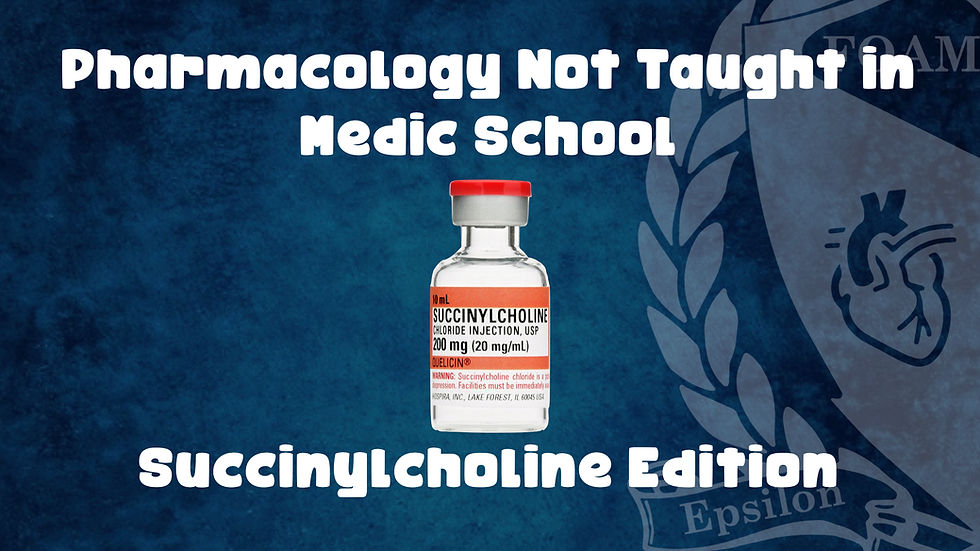Pharmacology Not Taught in Medic School: Versed Edition
- FOAMfrat

- Jan 21, 2022
- 4 min read

Okay, let’s talk all things Midazolam (Versed). It is a ubiquitous drug; we give it for anything from seizures to procedural sedation. Its mechanism of action is not unlike that of Etomidate but carries more of a hypotension risk that we will get to. Interestingly, how it causes hypotension may not be how you suspect and how it is metabolized can lead to excessively prolonged sedation in certain patients!
Welcome to the next blog series - “Pharmacology Not Taught in Medic School: Versed Edition”
I. Mechanism of Action
Versed, much like Etomidate, acts on the GABA receptor of the central nervous system. As a refresher, GABA receptors are the primary inhibitory receptor of the central nervous system. At the cellular level, it causes the CNS to become inhibited via the influx of Chloride anions through a central Chloride specific pore in the GABA receptor. This Chloride carries a highly negative Nernst potential of roughly -65 mV and causes the CNS cells to become hyperpolarized leading to reduced activity (less potential to generate an action potential).
The key difference in how Versed and Etomidate activate the GABA receptor is where the medication binds to. Etomidate binds to the GABA receptor sites while Versed binds to a specific benzodiazepine site. The benzodiazepine site is located, specifically, between the alpha and gamma subunits. This is opposite to Etomidate, which binds to GABA sites between the alpha and beta subunits.

Once Versed attaches to the benzo receptor site, it causes the receptor to express a higher affinity than usual to its own GABA neurotransmitter. Once the receptor becomes activated with the help of Versed, the chloride pore opens and allows the influx of chloride into the cell. So, Midazolam is considered a GABA agonist as it potentiates the effects of the receptor and ultimately hyperpolarizes the CNS cell.
II. Adverse Effects
We are namely concerned with hypotension in the setting of Versed administration. Many speculate that it causes direct vasodilation of vascular smooth muscle in the periphery. However, current evidence does not support this theory. Rather, Versed’s hypotensive side effects are mediated through another mechanism regulated through autonomic centers of the central nervous system.
In addition to being a GABA agonist, Versed also has an affinity for glycine receptors in the central nervous system. This is largely because glycine receptors are very structurally similar to GABA-A receptors – glycine receptors have 4 alpha subunits and 1 beta subunit versus GABA receptors that have 2 alpha, 2 beta and 1 gamma subunits (Lynch, 2004). The structural similarity lends itself to the reason that Versed attaches to both as both structurally look the same (like a lock and key model).
Glycine receptors also have a central chloride pore in which activation results in chloride influx and cellular hyperpolarization. However, the glycine receptors tend to be localized in areas of the CNS that control autonomic motor output, for example, vascular smooth muscle tension. Therefore, activation of these glycine receptors by Midazolam causes hypotension via indirect mechanisms and not direct vasodilation (Guritzky et al., 2001).
Also, to note, that these glycine receptors also control motor output that controls the diaphragm. Activation of these glycine receptors inhibits motor outputs to the diaphragm and can inhibit respiratory function and drive. This theory was supported in animal models showing that injections of glycine into the phrenic nerve inhibited its outflow (Chitravanshi & Sapru, 2002). This leads to the respiratory depression we see with the administration of Versed.

The two biggest concerns with Versed are hypotension and respiratory depression and both are mediated by glycine receptors in the autonomic motor output regions of the CNS. When Versed attaches to the glycine receptor, the influx of chloride essentially shuts down any neuronal control to the specific effectors, in this case, the vascular smooth muscle and the diaphragm.
III. Interesting Note
When Versed is administered and enters hepatic circulation, it is broken down by an enzyme known as Cytochrome P450. Midazolam gets broken down into two key compounds: alpha-hydroxymidazolam and 4-hydroxymidazolam. Although the two compounds share some degree of structural similarity, the 4-hydroxymidazolam is physiologically inactive and exerts no effect on the body. However, the alpha component is the primary metabolite and undergoes further degradation to form various “conjugate” compounds that exert sedative effects (Bauer et al., 1995).
When this active metabolite and its conjugates become an issue is when patients have severe renal impairment. These metabolites are excreted renally but when the patient has renal dysfunction, these metabolites and their conjugates can accumulate. This ultimately can lead to patients with renal dysfunction having very prolonged and heavy sedation effects from typical Versed dosing. In one study, supraphysiologic serum levels of these conjugates existed five days after versed administration! The clinical vignette is to be cautious with Versed in the setting of patients with renal failure (aka look for those fistulas!).

References
Bauer, T. M., Ritz, R., Haberthür, C., Haefeli, W. E., Scollo-Lavizzari, G., Ha, H. R., Hunkeler, W., & Sleight, A. J. (1995). Prolonged sedation due to accumulation of conjugated metabolites of midazolam. The Lancet, 346(8968), 145–147. https://doi.org/10.1016/s0140-6736(95)91209-6
Chitravanshi, V. C., & Sapru, H. N. (2002). Microinjections of glycine into the pre-Bötzinger complex inhibit phrenic nerve activity in the rat. Brain Research, 947(1), 25–33. https://doi.org/10.1016/s0006-8993(02)02902-5
Guritzky, R., Arain, S., & Ebert, T. (2001). Mechanism of Hypotension from Midazolam: Direct Vascular Versus Indirect Effects in Humans. Www.asaabstracts.com. http://www.asaabstracts.com/strands/asaabstracts/abstract.htm?year=2001&index=3&absnum=1808
Lingamchetty, T. N., Hosseini, S. A., & Saadabadi, A. (2020). Midazolam. PubMed; StatPearls Publishing. https://www.ncbi.nlm.nih.gov/books/NBK537321/
Lynch, J. W. (2004). Molecular Structure and Function of the Glycine Receptor Chloride Channel. Physiological Reviews, 84(4), 1051–1095. https://doi.org/10.1152/physrev.00042.2003




